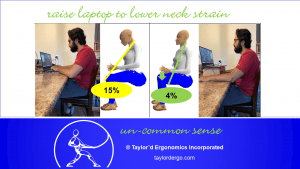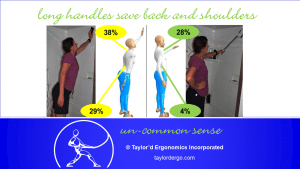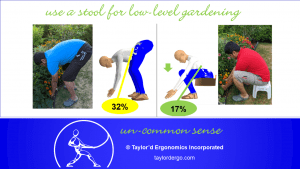Sara has been working with Jessica, Himangi, and Elisa, three interns from the Advanced Ergonomics Studies program at Fanshawe College. While internships are typically carried out in a more hands-on setting, the COVID-19 pandemic forced us to adapt. We set up a virtual placement to allow our interns to learn some very practical skills, which they’ll be challenged to apply in workplaces during their “in person” placements in September/October.
The interns have been asked to observe, measure, and assess everyday tasks, with the goal of identifying the best way to accomplish them. They analyse how tasks are commonly done, and use biomechanics software to prove best practices. Some best practices are basic common sense; we’ve all been taught to bend our knees or use a stool to reach an item on a high shelf. Others are more nuanced; what is the best way to carry a golf bag, pull weeds, or work on a laptop? For each task, the intern proposes a best practice, and then evaluates the demands on the body, for the common and proposed best practice. They want to show why a “best” practice is better than the common practice. They also describe, in detail, how it works, and how to encourage people to use the method.
Our goal is to develop a “bank” of best practices that we can use on our social media platforms (Facebook, LinkedIn, and Twitter), while giving the interns the most practical experience possible. The ability to compare work methods will be enormously helpful to their future employers!
We have “in person” internships lined up for September/October, when the interns will go into real workplaces and use the skills that they’ve developed virtually. They’ll already be trained to apply the biomechanical assessment tools, so they’ll have a head start. Have you ever debated with your co-workers about the best way to do a job? If you’re interested in some best practice work, let us know – we still have a few gaps in the fall schedule!
We’re sharing, below, the highlights of one best practice that each intern has generated so far. Keep an eye on our social media feeds for more of the great work our interns are producing!

Raise the laptop screen to reduce neck strain.
By raising the screen to eye height, the loads on the neck muscles can be reduced by over two-thirds!


Use a tool with a long handle for scrubbing
Long-handled tools can reach higher and farther than hands, and they reduce the loads not only in the arms, but also in the lower back.


Sit on a stool when gardening close to the ground
Using a stool in the garden can reduce the load on the back muscles by almost half!



